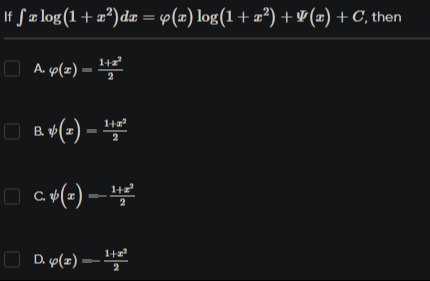Question
Question: If $\int x \log(1+x^2)dx = \varphi(x) \log(1+x^2) + \Psi(x) + C$, then...
If ∫xlog(1+x2)dx=φ(x)log(1+x2)+Ψ(x)+C, then

φ(x)=21+x2
ψ(x)=21+x2
ψ(x)=−21+x2
φ(x)=−21+x2
A, C
Solution
We need to evaluate the integral ∫xlog(1+x2)dx. Using integration by parts with u=log(1+x2) and dv=xdx, we get du=1+x22xdx and v=2x2. Applying the integration by parts formula ∫udv=uv−∫vdu: ∫xlog(1+x2)dx=2x2log(1+x2)−∫2x2⋅1+x22xdx ∫xlog(1+x2)dx=2x2log(1+x2)−∫1+x2x3dx To evaluate ∫1+x2x3dx, we can rewrite the integrand as: 1+x2x3=1+x2x(x2+1)−x=x−1+x2x So, ∫1+x2x3dx=∫xdx−∫1+x2xdx=2x2−21log(1+x2) Substituting this back: ∫xlog(1+x2)dx=2x2log(1+x2)−(2x2−21log(1+x2))+C ∫xlog(1+x2)dx=2x2log(1+x2)−2x2+21log(1+x2)+C Grouping terms: ∫xlog(1+x2)dx=(2x2+21)log(1+x2)−2x2+C ∫xlog(1+x2)dx=21+x2log(1+x2)−2x2+C Comparing this with the given form φ(x)log(1+x2)+Ψ(x)+C, we get φ(x)=21+x2 and Ψ(x)=−2x2. We can rewrite Ψ(x)=−2x2 as Ψ(x)=−21+x2−1=−21+x2+21. So the integral can be expressed as: ∫xlog(1+x2)dx=21+x2log(1+x2)−21+x2+(C+21) Thus, φ(x)=21+x2 (Option A) and Ψ(x)=−21+x2 (Option C) are correct.
